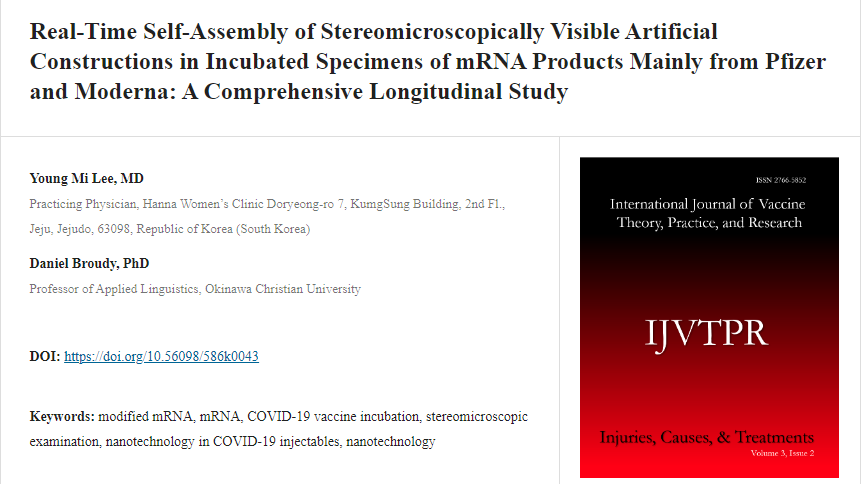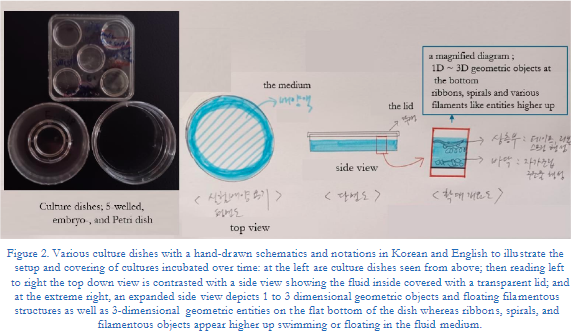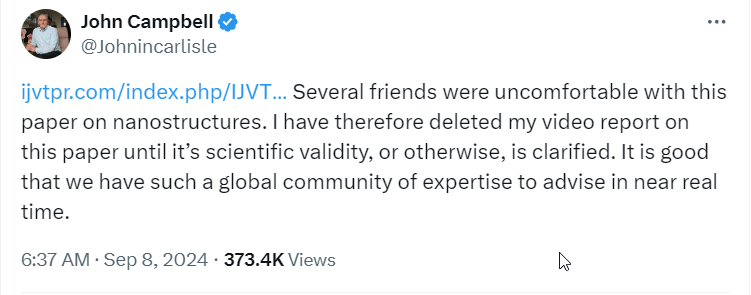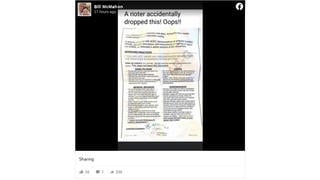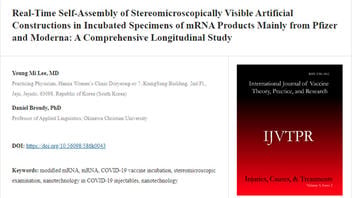
Is a 2024 article on mRNA COVID-19 vaccines by Dr. Young Mi Lee, an obstetrician and gynecologist in South Korea, and Daniel Broudy, an applied linguistics professor at Okinawa Christian University in Japan a valid, well-done scientific study? No, that's not true: The article -- titled "Real-Time Self-Assembly of Stereomicroscopically Visible Artificial Constructions in Incubated Specimens of mRNA Products Mainly from Pfizer and Moderna: A Comprehensive Longitudinal Study" -- was published in a journal that does not appear in the National Library of Medicine database. That database contains an overview of peer-reviewed, scientific journals. Experts contacted by Lead Stories described the study as "amateurish gibberish" written by authors who do not appear to have "any legitimate expertise in the field."
The article (archived here) was published in the International Journal of Vaccine Theory, Practice, and Research on July 18, 2024. The paper opened:
Observable real-time injuries at the cellular level in recipients of the 'safe and effective' COVID-19 injectables are documented here for the first time with the presentation of a comprehensive description and analysis of observed phenomena. The global administration of these often-mandated products from late 2020 triggered a plethora of independent research studies of the modified RNA injectable gene therapies, most notably those manufactured by Pfizer and Moderna. Analyses reported here consist of precise laboratory 'bench science' aiming to understand why serious debilitating, prolonged injuries (and many deaths) occurred increasingly without any measurable protective effect from the aggressively, marketed products.
This is what the post looked like on the International Journal of Vaccine Theory, Practice, and Research website at the time of writing:
(Source: International Journal of Vaccine Theory, Practice, and Research screenshot taken on Mon Sep 9 15:50:53 2024 UTC)
Under Author Biographies, the paper described Dr. Young Mi Lee, an obstetrician and gynecologist in South Korea, as "an expert in stereomicroscopy and in the microbiology of incubated COVID-19 injectables, especially, Pfizer and Moderna." Daniel Broudy, an applied linguistics professor at Okinawa Christian University in Japan, had no cited medical expertise.
The Abstract section of the paper concluded:
Our observations suggest the presence of some kind of nanotechnology in the COVID-19 injectables.
The authors said they observed "nanobot-like" structures or spirals in their research, suggesting that COVID-19 vaccines by Pfizer and Moderna contain nanobots.
Experts
Two infectious disease experts contacted by Lead Stories cast doubt on the paper. Dr. James Lawler with the Division of Infectious Diseases at the University of Nebraska Medical Center told Lead Stories in an August 15, 2024, email that the International Journal of Vaccine Theory, Practice, and Research, where the paper was published, is "not a real journal." He continued:
The paper ... should be a case study on how to spot disinformation. The content is scientific gibberish with no basis in actual biology or the scientific method. It is relatively amateurish gibberish, to be honest, that a reasonable person with a high-school level biology education should be able to easily debunk. ...
The methods and results sections are extensive, reflecting a common practice in disinformation and propaganda to overwhelm readers with a large volume of sciency-sounding prose. But, as I mentioned, the overall quality is amateurish. It's not every day you see crayon drawings in a science journal.
The drawing cited by Lawler is Figure 2 on page 1186 of the article. It appears below:
(Source: International Journal of Vaccine Theory, Practice, and Research screenshot taken on Mon Sep 9 16:39:46 2024 UTC)
In an August 15, 2024, phone interview with Lead Stories, Dr. William Schaffner, a professor of medicine in the division of infectious diseases at Vanderbilt University Medical Center, echoed Lawler's comments, calling into question the paper's integrity. He said:
This is an article that is written in a rather somewhat informal fashion, in a not-very-prominent journal. If this were truly a revolutionary finding validated by others, who would be referees, who are molecular virologists, for example ... I think it would be published in a mainstream journal. So I'm very skeptical.
Lawler agreed, citing "clues," that suggest the paper is "made-up propaganda." He continued:
These include the fact that the 'International Journal of Vaccine Theory, Practice, and Research' is not a real journal. A quick search of the US National Library of Medicine database confirms that this journal is not catalogued among peer-reviewed scientific journals.
The second clue is that the authors do not appear to have any legitimate expertise in the field. One is an OB-GYN who appears to have his own clinic in Korea, hardly a qualification to be an expert on vaccines, toxicology, or 'nanobots' (whatever those are).
The other author is a 'professor of applied linguistics' at Okinawa Christian University. Again, hard to understand how that gives him any applicable expertise. A quick visit to the school's website confirms that they have no listed department or faculty in life-sciences, or any sciences for that matter.
Schaffner noted that countries around the world have vaccine safety surveillance systems in place covering billions of people that would raise a red flag if something like "nanobots" were being found in people:
There have been no safety concerns regarding, I'm putting quotes, 'nanobots' in vaccines.
And of course, the Food and Drug Administration and other comparable agencies in other countries have not been able to ... determine that so-called 'nanobots' are in either persons or vaccines related to these mRNA vaccines.
Lawler pointed out other flaws he saw in the paper:
The experimental design (I use this term lightly) discussed in the paper is not scientifically sound, and is honestly bizarre.
Materials they described being used in their 'experiments' included beer, soju (a Korean distilled spirit), semen, and a cordless cell phone charger. I am not making that up.
While that sounds like a crazy night in Seoul, it doesn't really sound like good science. Because it isn't.
Pfizer
As it has previously, Pfizer dismissed the notion of "nanobots" in its products. In an August 15, 2024, email to Lead Stories, the company's media relations team said:
There are no nanobots in Pfizer-BioNTech's COVID-19 vaccine.
However, the Pfizer vaccines do include lipid nanoparticles, microscopic particles made from lipids, which are fatty molecules, in their COVID shot. An article on the Pfizer website explains how they work to deliver mRNA molecules into our cells after injection.
"Nano" in this case is a general measurement of the size of something that is less than 100 nanometers across. So, something that size would be a nano-something (nanoparticle, nanobot, etc.). A nanometer is a billionth of a meter.
Hesitant about vaccines
The study in the International Journal of Vaccine Theory, Practice, and Research is popular in antivaccine and vaccine-hesitant communities. Lead Stories previously debunked an article in The People's Voice (archived here) that used the paper to support its claim that Japan had declared a state of emergency in August 2024 after "nanobots" were found in 96 million citizens. There was no state of emergency and no nanobots were found.
The People's Voice is among the most prolific online publishers of fake news. Articles on the site often link to and extensively quote stories from other sites to give an appearance of legitimacy but the main claim in the headline and/or the first paragraph of each article is rarely supported by the sources that are offered. The site routinely makes up quotes from people or misrepresents scientific study results.
Additionally, popular YouTube host John Campbell, who has more than 3 million subscribers, also cited the study in a now-deleted video (archived here). Campbell explained why he pulled the video in a post (archived here) published to his account on X, formerly Twitter, on September 8, 2024. It appears below:
(Source: X screenshot taken on Mon Sep 9 16:39:46 2024 UTC)
According to the About page on his YouTube channel, his Ph.D. "focused on the development of open learning resources for nurses nationally and internationally."
Since starting his channel in 2007, he has posted thousands of videos on a variety of medical topics but has focused primarily on COVID since the start of the pandemic, promoting unproven treatments like ivermectin, spreading misleading death statistics minimizing the number of victims and misinterpreting data about vaccine safety.
Final word
In the conclusion of his email, Lawler added this about the claims surrounding the paper and others who cited it. He said:
There are no nanobots or other nefarious and mysterious additives in the FDA-approved COVID-19 vaccines.
The quality control, documentation requirements, and independent laboratory validation requirements of the US FDA are the strictest in the world.
Our COVID-19 vaccines have excellent safety profiles, have been administered to billions of people across the globe, and have saved tens-of-millions of lives.
We should celebrate the amazing achievement in American science they represent.
Read more
Additional Lead Stories fact checks of claims about vaccines and nanobots can be found here and here.

